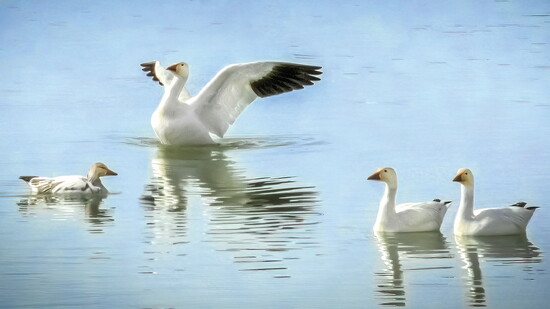My adventure began last February when I bundled up in layers of warm clothes, packed my camera, telephoto lens and a folding chair, and drove north to Delta with several photographer friends. Our destination was the annual Snow Goose Festival. The chance to observe and photograph thousands of these majestic avians up close was enough to coax me out of my warm home and cure the cabin fever that often plagues me during long winter days.
Delta is located in central Utah, just under 200 miles north of St. George. It is a place where on crisp, clear winter days one can sit in the sun, breathe in the fresh air and enjoy a peaceful day in the country. Unless, that is, you visit in February, when up to 20,000 noisy, migrating snow geese make Delta their home for a few weeks. Along with the geese, bird lovers and nature photographers, local families and out of towners and tourists, all flock to Delta, awaiting the show to observe these beautiful birds up close.
Snow geese are medium-sized birds, weighing between 4 and 6 pounds, with a long life span of up to 25 years. The snow geese that visit Delta are mostly all white except for their black-tipped wings. There are, however, a few of a different origin and color.
As an avid nature lover, I was delighted when I rounded a bend and came upon a sea of magnificent white snow geese floating leisurely on the water. Some were preening, some stretching their wings and others were pairing off, drifting side by side. It was a peaceful and captivating scene, and I stopped short to observe their beauty and grace.
Soon, as if at a drill sergeant's command, the flock came to attention, heads up and alert as they began paddling in perfect precision. They looked like one, great feathery blanket, billowing as they glided across the water. Then, without warning, the flock took to the air in a great flurry of feathers, with a breathtaking thumping of wings and a chaotic cacophony of honking. After takeoff, their movements slowed and they soared gracefully in the air above me, gliding and swirling in all directions like giant, white snowflakes.
The geese usually dine on unharvested grain from the fields in the morning, resting and moving about on the water around Gunnison Bend Reservoir during midday, then returning to the fields in the late afternoon or early evening to roost for the night.
Although snow geese were once an endangered species, they now thrive. During their migration, some travel as many as 3,000 miles and can fly as far as 1,500 miles in one day. But they are not as common to see in flight since they tend to travel in narrow flight lanes high in the sky.
Snow geese can migrate from Mexico and fly to the Arctic tundra. The flocks stopping in Delta, however, come from the Imperial Valley in Southern California and migrate to Anderson River in northern Canada—where they will build nests, mate and raise their young. Snow geese mate for life, but will find a new partner if their mate dies.
The geese usually arrive in the Delta area between the middle of February and the first week in March. There is no guarantee as to the exact date they will appear, but hopefully it coincides with the designated festival days.
During the festival, local wildlife biologists provide information and help tourists locate the birds for observation. Additional activities include a walk/run, entertainment and concessions. For more information, visit the Delta, Utah Snow Goose Festival website at visitmillardcounty.com/events/snowgoosefestival/
I have marked my calendar for Feb. 21 and 22 for the festival again this year. Maybe I'll see you there!
Snow geese mate for life, but will find a new partner if their mate dies.
